
Home Individual Weapons Squad MG Squad Mortar
BACKGROUND 
 
 
 
 
 
 
 
 
 
 
 
 
 
 |
MG42 Detail Page
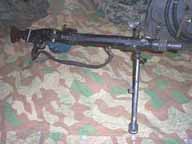
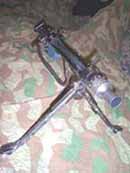
MG42 "Gas Gun"




This is were the chamber fits into the gun. I had to cut away some internal barrel latching stubs with a Dremel tool using metal cutting disks. On some guns you might have to build a stop to hold the chamber in the position/depth that you want. The sharp internal rails of my receiver just "bite" into the soft aluminum of the chamber to hold it in place and provide a good ground. 
I insert the chamber at an angle (without spark plug) close the latch and then screw in the barrel to determine the correct position. On mine the barrel and muzzle-cone is the only thing that holds the chamber in place.


The barrel is heavy wall "Black" 1/2" NPT pipe. The muzzle end has two flats milled into it for a wrench. The very end of the barrel is ground at an angle to match the inside of the MG42 muzzle-cone, this self-centers the barrel. Length is such that the cone will tighten close to the end of its travel with the cone-latch locking into a notch. It has to be a good tight fit for proper electrical grounding


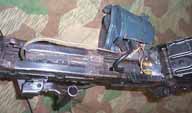
As you can see here the feed tray is cut and the middle portion removed. It is then screwed into the reciever on the drum side (the tray is first attached to the drum also using screws). The other side of the feed tray is sliced down to a slim piece but still pivots and allows the top cover pin to lock in place as usual. It also covers the notch made in the receiver for using the wrench on the gas inputs.

The feed tray latch on the drum is cut off as you can see here and the drum lid latch is used to open and shut the drum allowing access to adjust the fire rate. Note the position of the electric valves, the 1/8" copper tubing comes out of them with right angle elbows pointing straight up at the camera then bends off to go to the chamber. The the male ends of the quick-connects screw directly into the input side of the valves. The valves and coil are attached to an aluminum plate that sits at the bottom of the drum, it has two tabs bent up to match the angle of the inside drum wall. Small allen head screws go through the drum wall and are threaded into each of these tabs, two on each to hold the plate in place. Also note the fuse holder for a 7 amp fuse mounted with the electronic board on the drum lid. BATTERY:
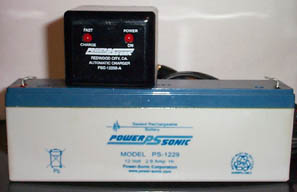 Gel Cell Battery and Smart Charger These batteries can be recharged hundreds of times and keep their charge for months but it is very important to get the right charger for your battery size. An electronic "Smart Charger" is really the way to go, they cost a little more but they reduce charging time and prevent over-charging that can quickly ruin you battery, and then nothing will work. The one to get is the POWERSONIC PSC-12250-A, the "A" stands for automatic and they are well worth the slight extra cost. They also are the only type that has LED indicator lights so you can make sure your charger is on. Again batteryweb.com has the best prices and you can find their chargers on this page. TANKS:
Here is a close up of the backpack tanks. I don't use the cast A-B foam anymore the damn stuff doesn't keep so I have lost money on it everytime when it hardens up in the can. I use sheet foam that I cut and glue to fill out the shape of the backpack, it really doesn't have to be that big, I used a much smaller set up in a tiny GI pack with the battery in the meat tin pouch for the US Browning 1919A6.


The yellow tanks are disposable MAPP gas bottles, the green and silver is the smallest Oxygen tank, holding 4 cubic feet. In case you didn't already guess I use MAPP gas exclusively, I have discovered that it ignites easier and does not produce water as a by-produce of combustion like straight propane (so it won't short out your plug). For those of you who are unfamiliar with MAPP it is a mixture of 56% Acetylene and 44% LPG, comes in a yellow bottle and costs about $9 at most hardware stores. It has more of a blue flame when fired but it really makes these things dependable, you have to watch long bursts however as it does burn hotter and will actually melt your sparkplug tip.
I use the smallest regulators Victor makes, SR150CR oxygen and SR160AR acetylene and get them wholesale. Call a local shop and see what it will cost to order them, I can sell them for around $75 each. You can see the locking screws and nuts on the regulator adjustments, I have recently machined a new type that are a lot easier to use. 

Above shows the liquid "gas trap" I made out of 1/4" brass fittings, this keeps liquid gas from going into the regulator when the operator is on the ground with the backpack on. You don't really need this if you have a vehicle mounted or stationary gun. There are quarter turn ball valves for turning on/off the MAPP gas and special adapter for attaching the Victor SR160AR regulator. 
Since I can't ship filled Oxygen tanks anyway I recommend you purchase them yourself and have them filled locally. I use the #M004 Medical LUXFER solid aluminum tanks, (small steel ones are TOO HEAVY). I have found that the Industrial grade tanks are usually special order and more expensive, the medical ones have a much bigger market and are more common and thus less expensive and easier to get. The only difference between the Medical M004 and the Industrial N004 is that the Medical one is painted green around the top. If you have trouble having them filled (some shops require a Doctor's Rx) you can remove the paint or paint over them with grey or silver. If you just can't find anyone to purchase them from I can order them. The M004 are 3.2" Diameter and 9" in height and about 12" high with the #540 (regular welding type) valve installed. They hold 4 cubic feet of Oxygen at 2216 PSI. Weighs 1.9 lbs. without valve. I usually need three of these for a 2 day weekend battle event, changing bottles around noon on Saturday and then using the third for our half day on Sunday. These small tanks also just fit in a standard 8mm 250 round ammo can, you can get it and the MAPP bottle in one can so it is just right for those field reloads!
There is also the M007, 4.4" diameter 9.3" high. ~12.3" with valve, holds 7 cubic feet of Oxygen at 2216 PSI. Weighs 3.6 lbs. without valve cost on that was around $55. For about $60 there is the M009 just 1.6" taller and .2 lbs heavier but holds 8.8 cubic feet at 2015 PSI, I use these on vehicle mounted guns, usually 2 for a weekend. Here is some info on cylinder suppliers, these are often special order tanks and it is almost certain that most local welding shops will not have these in stock so check into it early if you are working on a deadline for an event. If you are unable to find any locally I can get them for you. Cylinder Suppliers:
Conwin Carbonic
Special Gas Systems
DCG Partnership 1, Ltd.
Pacific Cylinders
Haring Cylinder Company
Pacific Cylinders
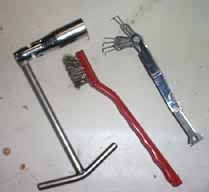
Here are some tools I find useful in the field, plug wrench, plug cleaning brush and a spark gap measuring/adjusting tool with file. Here is an mpg video of a test on my gun, the mpg format did not capture all of the muzzle flashes that were seen in the original video, they were the same time and duration as the sound. The sound is not really representative as it was so loud it pinned out my mike and recorder.
Best if viewed with Windows Media Player 6.4 or higher. DOWNLOAD MEDIA PLAYER NETSCAPE PLUG IN This test was run with the Oxygen at 25 PSI and MAPP GAS at 8.5 to 10 PSI. An empty gas cylinder is used as a low pressure MAPP GAS reservoir in the backpack. Spark gap on the plug was .062", kind of wide but it works. If you use different regulators it can be very difficult sometimes to get you gun to work, small changes in the PSI of either gas or the fire rate adjustment can screw you up. I make locking set screws for my regulators so I don't lose the settings. Changing plugs may change the way the gas mixes because the electrode doesn't always end up in the same position. Set the gas levels and tweek the fire rate until you get something KEEP TRACK of the turns or you will get lost. Fire short bursts to adjust it and warm it up and then see if you can rip a longer one. UPDATES: I now use smaller valves sets from Steve Smith , they take less power. There is a new snowmobile coil out now that is about the same size as the one I put in the drum. The good thing is that is has a connector on the coil that allows any length of spark plug wire.
Another test was run and it was a bit louder but uses more gas. |